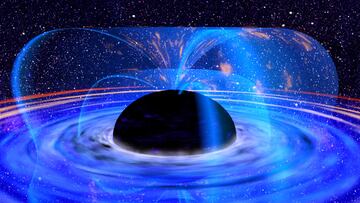The mutation of PBC J2333.9-2343, the supermassive black hole with a blazar at its core
A team of international astronomers reclassified a galaxy after the black hole at its center turned 90 degrees directing high energy jet directly at Earth.

What had been considered just a radio galaxy, was reclassified as a giant radio galaxy by a team of international astronomers after “unique activity within its core.” At the heart of the galaxy in question, PBC J2333.9-2343, is a supermassive black hole which became a blazar when its relativistic jet turned 90 degrees pointing it directly at Earth.
The findings were published in Monthly Notices of the Royal Astronomical Society after researchers made observations across a wide range of the electromagnetic spectrum. “We started to study this galaxy as it showed peculiar properties,” said lead author of the paper and researcher at the Millenium Institute of Astrophysics Dr Lorena Hernández-García in a statement.
“Our hypothesis was that the relativistic jet of its supermassive black hole had changed its direction, and to confirm that idea we had to carry out a lot of observations.”
NASA releases audio of what a black hole sounds like pic.twitter.com/TfnWO2kkhm
— Historic Vids (@historyinmemes) March 23, 2023
What is a blazar?
Blazars are essentially quasars, both of which are active galactic nuclei (AGN), the immense black holes that are at the center of most galaxies. As gas, dust and other objects in the galaxy are captured in the gravitational pull of the black hole they begin to collect in a swirling accretion disk. As the matter falls in toward the black hole, the accretion disk emits bright light giving AGN’s their name.
In some cases AGN spew relativistic jets which are made up of high-energy particles that travel close to the speed of light. When that jet is pointing at the Earth it is known as a blazar, otherwise it’s a quasar. In the case of PBC J2333.9-2343, there was “a dramatic change of the jet direction” coming from its core, up to 90 degrees.
A pulse of intense radiation swept through our solar system that astronomers called the BOAT: the brightest of all time.
— Hubble (@NASAHubble) March 28, 2023
Several @NASA missions, including Hubble, have followed up to study this gamma-ray burst, likely caused by the birth of a black hole: https://t.co/zCPiiamLL8 pic.twitter.com/xSRRLzD0dy
What caused the mutation of PBC J2333.9-2343?
The astronomers were able to determine that the jets had deviated from a previous trajectory based on observed evidence from two “very old” lobes” which showed “relics of past activity” by the jets. “The fact that we see the nucleus is not feeding the lobes anymore means that they are very old. They are the relics of past activity, whereas the structures located closer to the nucleus represent younger and active jets,” Dr Hernández-García said.
Related stories
The researchers don’t know at this time what caused such a big change in the orientation of the jets. Speculation centers on a “major event” such as a merging event with another smaller galaxy or another black hole which resulted in a tidal interaction causing the jet axis to flip rapidly.
The galaxy itself spans around 4 million light years across, roughly 38 times the size of the Milky Way, and is located almost 657 million light years away.


